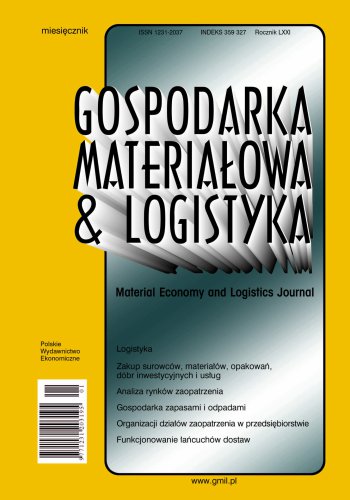Teamwork in the supply chain – a systematic and bibliometric analysis (part 2)
Praca zespołowa w łańcuchu dostaw – systematyczna i bibliometryczna analiza literatury (cz. 2)
The success of supply chains depends primarily on integrating and coordinating the activities of network participants. Many supplier companies are shifting toward team-based structures to manage the boundaries with their customers. One of the possibilities of the operational implementation of cooperation in the supply chain is the appointment of teams in the network structure. The paper aims to orient researchers who are new to collaborative work in supply chain research. The study conducted by the authors used both a systematic literature review and bibliometric analysis. The second part of the paper includes in-depth analysis of clusters identified for the teamwork in the supply chain based on the analysis with the TreeCloud tool and VOSviewer software performed in the first part. Authors of the paper did the synthesis of both analyses with an in-depth reading of the seminal studies according to the identified clusters. The second part of this paper also contains summary with conclusions where trends in the field of supply chain collaboration by teamwork are identified. Following the research results, three main topics should be investigated in future research: the impact of cross-functional and cross-organizational teams on supply chain integration and performance and the ways of managing cross-functional and cross-organizational teams in the supply chain communication in cross-functional and cross-organizational teams.
Sukces łańcuchów dostaw zależy przede wszystkim od integracji i koordynacji działań uczestników sieci. Wielu dostawców przechodzi na struktury oparte na zespołach, aby zarządzać granicami organizacji wraz ze swoimi klientami. Jedną z możliwości operacyjnej realizacji współpracy w łańcuchu dostaw jest powołanie zespołów w ramach struktury sieciowej. Artykuł ma na celu ukierunkowanie badaczy, dla których badania nad pracą zespołową w łańcuchu dostaw są pewnym novum. W badaniu przeprowadzonym przez autorów zastosowano zarówno systematyczny przegląd literatury, jak i analizę bibliometryczną. Część druga opracowania zawiera dogłębną analizę klastrów, jakie zostały wyznaczone dla tematyki pracy zespołowej w łańcuchach dostaw przy użyciu zaprezentowanego w pierwszej części artykułu narzędzia Treecloud i oprogramowania VOSviewer. Autorzy dokonali syntezy klastrów utworzonych za pomocą obu narzędzi w postaci dopasowania szerokiej perspektywy zidentyfikowanej narzędziem TreeCloud do węższych klastrów wskazanych w oprogramowaniu VOSviewer. W drugiej części artykułu zawarto również wnioski z przeprowadzonych badań. Wyniki badania sugerują, iż w przyszłych badaniach należy skupić się na trzech głównych tematach: wpływie zespołów międzyfunkcyjnych i międzyorganizacyjnych na integrację i wydajność łańcucha dostaw oraz na sposobach zarządzania tymi zespołami w komunikacji w łańcuchu dostaw w zespołach międzyfunkcyjnych i międzyorganizacyjnych.
Bibliografia
References/Bibliografia
Birdi, K., Clegg, C., Patterson, M., Robinson, A., Stride, C. B., Wall, T. D., & Wood, S. J. (2008). The impact of human resource and operational management practices on company productivity: A longitudinal study. Personnel Psychology, 61(3), 467–501. https://doi.org/10.1111/j.1744-6570.2008.00136.x
Bititci, U., Garengo, P., Dörfler, V., & Nudurupati, S. (2012). Performance measurement: Challenges for tomorrow. International Journal of Management Reviews, 14(3), 305–327. https://doi.org/10.1111/j.1468-2370.2011.00318.x
Chopra, S., & Sodhi, M. M. S. (2004). Managing risk to avoid supply-chain breakdown. MIT Sloan Management Review, 46(1), 53–61.
Cousins, P. D., & Menguc, B. (2006). The implications of socialization and integration in supply chain management. Journal of Operations Management, 24(5), 604–620. https://doi.org/10.1016/j.jom.2005.09.001
Denyer, D., & Tranfield, D. (2009). Producing a systematic review. In: D. A. Buchanan & A. Bryman (Eds), The Sage Handbook of Organizational Research Methods (671–689). Sage Publications.
Fawcett, S. E., Osterhaus, P., Magnan, G. M., Brau, J. C., & McCarter, M. W. (2007). Information sharing and supply chain performance: The role of connectivity and willingness. Supply Chain Management, 12(5), 358–368. https://doi.org/10.1108/13598540710776935
Graves, S. C., & Willems, S. P. (2000). Optimizing strategic safety stock placement in supply chains. Manufacturing and Service Operations Management, 2(1), 68–83. https://doi.org/10.1287/msom.2.1.68.23267
Jagoda, A., Kołakowski, T., Marcinkowski, J., & Skowrońska, A. (2023). Teamwork in the supply chain – a systematic and bibliometric analysis (part 2). Gopodarka Materiałowa i Logistyka, (1). https://doi.org/10.33226/1231-2037.2023.1.3
Klimas, P., Stańczyk, S., & Sachpazidu-Wójcicka, K. (2020). Metodyka systematycznego przeglądu literatury – wyzwania selekcji a posteriori podczas tworzenia bazy literatury. In: A. Sopińska, & A. Modliński (Eds.), Współczesne zarządzanie – koncepcje i wyzwania (39–52). Oficyna Wydawnicza SGH.
Lambert, D. M., García-Dastugue, S. J., & Croxton, K. L. (2005). An evaluation of process-oriented supply chain management frameworks. Journal of Business Logistics, 26(1), 25–51. https://doi.org/10.1002/j.2158-1592.2005.tb00193.x
Lee, H. L., & Billington, C. (1995). The evolution of supply-chain-management models and practice at Hewlett-Packard. Interfaces, 25(5), 42–63.
Menon, S. T. (2012). Human resource practices, supply chain performance, and wellbeing. International Journal of Manpower, 33(7), 769–785.
Petersen, K. J., Handfield, R. B., & Ragatz, G. L. (2005). Supplier integration into new product development: Coordinating product, process and supply chain design. Journal of Operations Management, 23(3–4), 371–388. https://doi.org/10.1016/j.jom.2004.07.009
Prajago, D., & Sohal, A. (2013). Supply chain professionals: A study of competencies, use of technologies, and future Challenges. International Journal of Operations & Production Management, 33(11/12), 1532–1554.
Ragatz, G. L., Handfield, R. B., & Scannell, T. V. (1997). Success factors for integrating suppliers into new product development. Journal of Product Innovation Management, 14(3), 190–202. https://doi.org/10.1016/S0737-6782(97)00007-6
Sassetti, S., Marzi, G., Cavaliere, V., & Ciappei, C. (2018). Entrepreneurial cognition and socially situated approach: A systematic and bibliometric analysis. Scientometrics, 116, 1675–1718.
Tracey, M., & Tan, C. L. (2001). Empirical analysis of supplier selection and involvement, customer satisfaction, and firm performance. Supply Chain Management, 6(4), 174–188. https://doi.org/10.1108/EUM0000000005709
Van Echtelt, F. E. A., Wynstra, F., Van Weele, A. J., & Duysters, G. (2008). Managing supplier involvement in new product development: A multiple-case study. Journal of Product Innovation Management, 25(2), 180–201. https://doi.org/10.1111/j.1540-5885.2008.00293.x
Vickery, S. K., Jayaram, J., Droge, C., & Calantone, R. (2003). The effects of an integrative supply chain strategy on customer service and financial performance: An analysis of direct versus indirect relationships. Journal of Operations Management, 21, 523–539.

